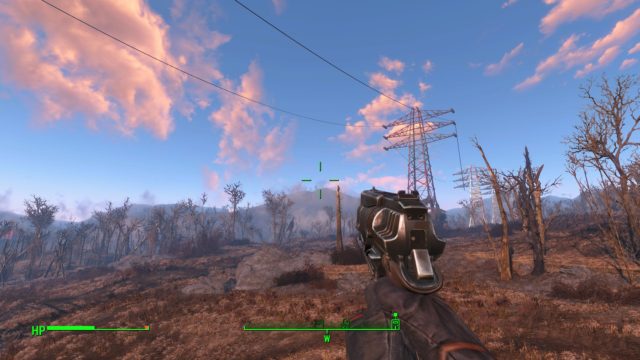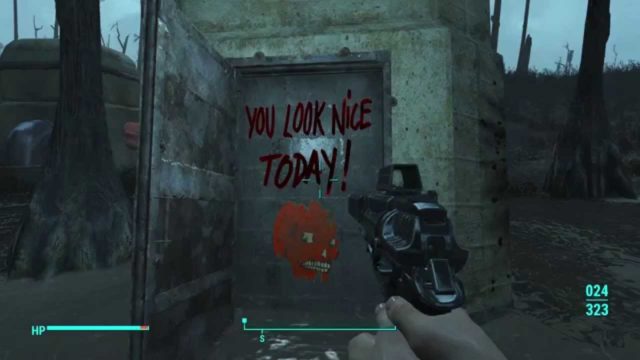
Beginning in 1997 with the release of the first installment, Fallout is a series of action role-playing games originally developed by Black Isle Studios for Microsoft Windows and Mac OS X. After the release of Fallout 2, the main series took a decade long break when Black Isle closed after getting bought out by Interplay Entertainment. Bethesda studios released Fallout 3 on October 28, 2008 for both PC and consoles. Fallout 3 was a highly acclaimed game, receiving many awards and gaining the series a lot of attention.
In 2015, Bethesda release the latest installment in the franchise. Fallout 4 is an open-world game set in a post-apocalyptic United States. In the world of the narrative, your family enters an underground nuclear bomb shelter in 2077, and you alone emerge into the post-war wasteland in 2287. Your spouse is dead, and your main goal is to find your son who was stolen from the vault as a baby.
Game Trailer:
Gameplay Demo from E3 2015:
I — The Lens of Elemental Tetrad
Aesthetics:
From Pip-Boy menu to the radioactive craters, Fallout 4 has post-war aesthetic that it unfalteringly adheres to. The series creates a world that does not vary much between the games. The Fallout games unify even its most inconsequential assets right down to Washo detergent. Any long time player of the series would be able to list off the fictional branding within the Wasteland.
Technology:
Fallout 4’s graphics paired with its open world gameplay was at the top of the industry at the time of its release. Starting with Fallout 3, the series uses realistic 3D models to depict the Wasteland, and interactions between the player and NPCs are mostly realtime. One of Bethesda’s main goals between each of the studio’s releases is a complete graphics overhaul. Fallout 4 was no exception, and the studio pushed out another environment full of props and enemies ready to be explored.
Mechanics:
Fallout 4 mechanics are pretty basic as far as current games go. The player has the option between first and third person, and the camera and player movement is controlled by the joysticks or a keypad and mouse, actions are handled using the trigger or mouse click, and so on. The really defining mechanic of the series is V.A.T.S., a targeting system which allows even inept players to take out enemy targets.

Screenshot: View of an active V.A.T.S. mechanic.
After some amount of recharge, a player can use V.A.T.S. to queue specific shots at specific body parts of nearby targets. This system is a call back to the turn-based combat of the first two installments of the series.
Story:
Storywise, the Fallout games tend to follow some variation of the same the narrative: the player emerges from a vault shelter into the Wasteland for the first time and with no knowledge of the current state of the world, and he or she must seek out some other person. Fallout 4, like the others in the series, has its nuances, but after several games of a similar plot, the story comes second to just exploring the world and completing side quests.
Enhancements and harmony?
The two major areas that Fallout 4 could be enhanced in is in story and in mechanics. The names and faces change with each new title, but because of the strong aesthetics across the series, each new game feels more and more like a remake of the last, just with improvements to the technology. Along a similar thought, adding a new mechanic to the game has the potential to refresh the story. Fallout 4 attempted this through it’s settlement building system, where the player could create and operate their own settlements at various sites throughout the map. Unfortunately, the feature ended up having the feeling of post-apocalyptic Sims, and did not greatly affect the rest of the gameplay. Because the settlements mechanic lacked integration, the game felt unbalanced at times. A player could spend hours of the game creating a massive settlement with all the best artillery, and still not have made any progress in the actual storyline of the game.
II — The Lens of Time
- The time it takes to complete Fallout 4 is completely at the hands of the player. If the player finds pleasure in a particular type of quest within the game, he or she is more likely to continue playing and exploring the open-world map.
- Fallout 4 has the potential to frustrate players by its scale and the length of time it takes to complete quests. The player can go through only the main quest line, but they will experience greater difficulty as the game progresses because many of the perks are buried in the dozens of side quests.
- If a timing system were to be installed, the player’s freedom to explore the Wasteland would be lost. Fallout 4 is a modern take on a choose your own adventure story, and with that there is no easy way to cap the amount of time quests should take.
III — The Lens of Goals
- At its root, the goal of the player is to find their son and change the society of the game to fit their ideology by aligning with one of the game’s four factions.
- The goal is reiterated many times by the NPCs and dialogue options of the player.
- The goal is met as the player moves through the Wasteland and learns more about its inhabitants.
- Achieving these goals is secondary to the enjoyment of actually experiencing the game. The more creatively a player can change the course of a game, the more rewarding completing the goals are.
- There are plenty of short term goals a player can achieve by accepting side quests. Completing side quests ultimately makes achieving the main goal more fulfilling.
- The player is in control over how many of the narrative’s goals they complete, and whether or not they complete them for good or for evil.
IV — The Lens of Physical Interface
- The player can examine almost any asset in the game. While not all of these assets are destructible, there is still a huge level of interaction between the player and the environment.
- This interaction is done entirely through a keyboard or console controller, so the player’s experience of the game relies entirely on the audio and visuals of the game.
- The best physical mapping of the game is through a console controller, which shakes and vibrates alongside the world of the game.
- If the player uses a gun, the trigger on the controller is an accurate mapping, but the player can use any number of weapons. If the player chooses to use a bat or fists as weapons, the physical interface becomes much less direct.
V — The Lens of the Weirdest Thing
- Fallout is known for its weirdness. It is the most endearing quality of the game, and the reason fans remain so loyal. These nonsensical moments and hidden scenes are scattered throughout the map where only players who leave the main story to seek their own adventure may find them.

Screenshot: Fallout 4 easter egg.
- The weird moments may confuse the player, but they never break the rules the game has laid.
- Easter eggs in Fallout are usually allusions to pop culture.
- Fallout 4 uses its weirder moments to break up the sameness of the Wasteland and it’s quests.
